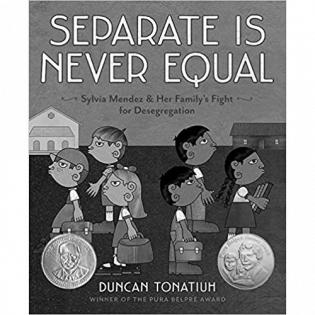Separate Is Never Equal Literature Guide
Stylistically illustrated, this book documents the first fight for racial integration of public schools in the United States. Follow Sylvia Mendez and her family as they relentlessly work for school desegregation in California in the 1940’s.
Literature Guide by Lea Sevigny
Before Reading
Ask: Consider the title of this book, Separate Is Never Equal. What do you think that phrase means? What do you already know about the history of segregation of children of different backgrounds in schools?
Show: Look at the illustrations in the book. Duncan Tonatiuh’s style is influenced by Pre-Columbian art. What do you notice about the illustrations?
Connect: In the United States today, all children are allowed to go to school together, regardless of race, but that wasn’t always the case. Read the true story of Sylvia Mendez to find out more about segregation.
During Reading
Ask: What does “separate but equal” mean? Use the glossary on p. 38 to define it. Why do you think so many people from different backgrounds from all over Orange County, and later from all around the United States, got involved in the Menedez case? Sylvia's mother said, "When you fight for justice, others will follow."
Show: Notice in the illustrations how people are there for each other even when times are difficult. In what ways do the illustrations convey the importance of family and community?
Connect: “Your children have to go to the Mexican school” was a statement Mr. Mendez heard over and over, but no one gave him a satisfactory answer as to why. It would have been simpler for Mr. Mendez to back down and think that’s just the way it is. He decided it wasn’t right so he sacrificed and worked hard to do something about it. Talk about times you’ve noticed when things didn’t seem just or fair.
After Reading
Ask: You don’t have to be an adult or go to trial to make a difference. How do you see yourself reflected in Sylvia’s story? Your voice is valuable. How might you use it to make meaningful contributions to your community?
Show: Duncan Tonatiuh did a lot of research to create this story. Look at p. 37 - 39 to see photographs, a glossary of terms, and a bibliography that all add background and credibility to his work.
Connect: Sylvia’s family spent years sacrificing their time and money on this effort, not only for their own family but for all children in their community and ultimately the state of California. What issues do you think you and your family would be willing to work that hard for?
Activities:
- Read the “Author’s Note” on page 36 to better understand the true events on which this story was based. Duncan Tonatiuh tells how inequality is still an issue today. What questions do you have now that you’ve read the background and changes due to the Mendez’s fight? What topics might you like to learn more about?
- Despite the Mendez victory, schools throughout the United States were still segregated. Seven years later the famous case Brown v. Board of Education desegregated schools in the rest of the country. Research that case and talk about what aspects of school still aren't equitable today.
- Research the mission of the organizations that gave the Mendez family support during their second trial: League of United Latin American Citizens, National Association for the Advancement of Colored People, Japanese American Citizens League, and American Jewish Congress
- Two people played an important role in the Mendez v. Westminster School District case and would later go on to have further significance in U.S. history: Thurgood Marshall and Earl Warren. Research their careers and create a Venn Diagram comparing and contrasting the two men.
- Mexican-American author and illustrator Duncan Tonatiuh was influenced by ancient Mexican art, but he uses modern technology innovatively to “color” in his drawings. Look up Duncan Tonatiuh on the Art Is Basic website to watch a video of his process and learn more about his work. Reflect on what you learned by describing his process, writing what you think about it, what excites you, what questions you have, etc.
- Sylvia Mendez spent her life fighting for equality and civil rights. In 2011, President Barak Obama honored her with the 2010 Presidential Medal of Freedom. Research this award. Create a slide presentation to share the story of this honor. You may include pictures of her fighting for civil rights over the years; tell why she received the award; embed a link to the video showing her acceptance speech; show past honorees and why they received the award; or make other connections that interest you.
